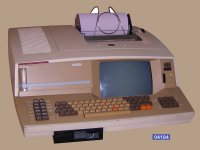RetroHospital
Experienced Member
Hello !
One 37kg (I suppose that's 70 pounds) beast landed in my house, a 1985 Telex / teletypewriter model sagem, used in a lot of countries under different names

The unit works fine however it refuses to do anything complaining of "telex line", I suppose it wants the telephone network and this won't happen anytime soon, telex network has been shut down in 1996 around here.
WOuld anyone have by any chance
- a user manual for one of these ( I found a small maintenance document of telecom australia online, but that doesn't help)
- used one in the past and know out to get out of the "locked mode" which is the only thing it does when it doesn't see the telex line currently
The only interactive thing I can do is go in "test mode" (just after boot), which confirms the units works greats ; but it gets out of test mode after 20 sec of inactivity ;( and then you've got a screen the unit is "locked" (there's that message on top of the screen) and the keyboard does nothing.
thanks !
One 37kg (I suppose that's 70 pounds) beast landed in my house, a 1985 Telex / teletypewriter model sagem, used in a lot of countries under different names

The unit works fine however it refuses to do anything complaining of "telex line", I suppose it wants the telephone network and this won't happen anytime soon, telex network has been shut down in 1996 around here.
WOuld anyone have by any chance
- a user manual for one of these ( I found a small maintenance document of telecom australia online, but that doesn't help)
- used one in the past and know out to get out of the "locked mode" which is the only thing it does when it doesn't see the telex line currently
The only interactive thing I can do is go in "test mode" (just after boot), which confirms the units works greats ; but it gets out of test mode after 20 sec of inactivity ;( and then you've got a screen the unit is "locked" (there's that message on top of the screen) and the keyboard does nothing.
thanks !
Last edited:
